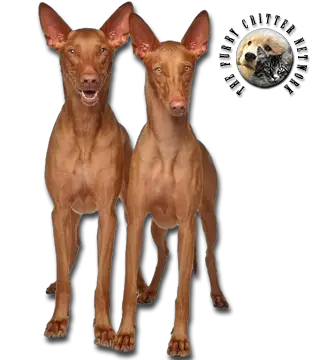Breed Standard
Head: Blunt wedge shape. Long, dry, finely chiseled skull. Slight stop. Nose bridge slightly longer than the skull. Flesh color nose. Powerful jaws.
Ears: Large. Thin leather. Broad at the base. Carried erect but very mobile.
Eyes: Oval shape. Amber color matching the coat.
Body: Supple, almost square. Long, dry, muscular neck without dewlap. Chest is well let down. Ribs well sprung.
Tail: Fairly thick at the root and tapering to the tip. Hangs down just past the hocks when at rest. Carried high and curved when in action.
Hair: Short, smooth, glossy, ranging from fine and close to slightly harsh.
Coat: Self-color fawn with white markings on the tip of the tail (bly desired), on the forechest (star), and on the toes. Narrow white stripe on the face is permissible.
Size: Dog: 56 to 63.5 cm Bitch: 53 to 61 cm
Weight: Approx. 28 kg
History
The Pharaoh Hound looks like the prick-ear hounds depicted in paintings on ancient Egyptian tombs. From Egypt, the breed spread to Europe through Spain and was maintained in the Balearic Islands.
Behavior
This active, very swift, supple dog is an excellent jumper and eager hunter (rabbit, hare, pheasant, etc.). He is a loving, affectionate, playful pet.
The Pharaoh Hound is not suited to life as a house dog. He needs frequent exercise. Regular brushing is required.
Function
Hunting Dog, Pet.
Health
Pharaoh hounds, being somewhat uncommon outside of the Maltese Islands of Malta and Gozo, and because they are not profitable for commercial breeding, have not been subjected to as much irresponsible breeding as some more popular breeds. Breeders try hard to prevent hereditary diseases from entering the gene pool and according to the American breed club, Pharaohs are virtually free from genetic diseases. Reputable breeders continue to test their breeding stock for genetic conditions such as hip dysplasia, luxating patellas, and myriad eye conditions just to ensure that these disorders do not become a problem. Reputable breeders should be able to show documentation of health screening performed on their breeding dogs. Note that Pharaohs, like most sighthounds, are sensitive to barbiturate anaesthetics. Their ears are thin and prone to frostbite when in cold climates.






